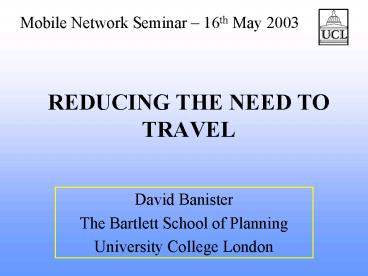REDUCING THE NEED TO TRAVEL - PowerPoint PPT Presentation
1 / 21
Title:
REDUCING THE NEED TO TRAVEL
Description:
Car Free Development Gruenenstrasse in Bremen. Transport Development Areas ... Affordable housing units and car free developments ... – PowerPoint PPT presentation
Number of Views:13
Avg rating:3.0/5.0
Title: REDUCING THE NEED TO TRAVEL
1
REDUCING THE NEED TO TRAVEL
Mobile Network Seminar 16th May 2003
- David Banister
- The Bartlett School of Planning
- University College London
2
The New Realism
Stage 1 - Consensus that projected traffic growth
is not sustainable Stage 2 - Proposed road
schemes will not solve the problem Stage 3 -
Limitations on the use of the car and
substantially raising the costs of travel Stage 4
- Awareness of the environmental and social costs
of unlimited mobility Stage 5 - Reduce the need
to travel - the only means to improve the
environment and congestion
3
The Universal Problem
4
Economic Solutions
- Internalising the social costs of transport
through the pricing mechanism - Fuel duty increases - but this will not stabilise
CO2 emissions until 2010 abandoned in 1999 - Transport in EU15 has increased its carbon
emissions by 160 m tonnes from 1990 - 2000 - A real doubling of petrol prices will reduce
growth in traffic (1992-2006) from 65 to 30 -
only a tripling of petrol prices will maintain
traffic at current levels.
5
Technological Solutions
- Technology has always solved the problems in the
past and will solve them now - Catalytic converters
- Cash for clunkers
- Electric, hybrid and hydrogen vehicles
- Regional clean air incentives market (RECLAIM)
- Alternative fuels
6
Electric vehicles in Lillehammer
Mercedes New Electric Car (NECAR3)
7
Free electric recharging in Copenhagen and Free
unrestricted parking for electric vehicles in
London
8
Land Use and Planning Solutions
- Reduce journey lengths higher use of public
transport and green modes of transport - Encourage trip chaining location of services
and facilities in close proximity - Promoting high quality locations, including
public transport interchanges where people want
to spend time at with facilities transport
development areas of
9
Land Use and Planning Solutions
- Sustainable transport policy - Sustainable
development - 1. Development Principles
- 2. Social Audit
- 3. Quality Neighbourhoods
10
Development Principles
Concentration and Diversity of Activities
Vitality
Less need to travel
Environmental security
Less reliance on the car
More use of green modes and public transport
More attractive and better quality town centres
Economic, Social and Environmental Benefits
11
Development Principles
- 1. Density of Development
- As density increases
- Average trip length reduces
- Use of the car reduces
- Distance travelled reduces
- But causality has not been proved
12
(No Transcript)
13
2. Size of Settlement
- The larger the settlement
- Shorter the trips
- Greater proportion of trips by public transport
- Use of car and total distance travelled decreases
- Thresholds need to maintain balance between
people, jobs and a full range of facilities
14
3. Availability of Employment
- Increases in consumption of travel by car
commuting in UK is 60 from 1981-1991 - Need to put workplaces nearer to where people
live, but the nature of work is changing - Also locate workplaces in larger and public
transport accessible locations
15
Social Audit
- 1. Social Costs of Closure
- Savings to provider and additional costs to
user - 2. Social Costs of New Development
- Benefits to local economy and users of the new
facility, extra travel (if any) - 3. Development Levy
- On locations inaccessible by public transport
16
Quality Neighbourhoods
- Locations where people, public transport and
local facilities take precedence over the car - Efficient interfaces between transport modes
- Non polluting local transport
- Provision of local based facilities
- Monitoring and control technologies to maintain
high environmental quality
17
Clear Zones and limited access areas -
Interchange point at boundary
18
Streets for People
19
Car Free Development Gruenenstrasse in Bremen
20
Transport Development Areas
- At public transport accessible locations
- Encouragement of multi modal trips
- Office location and retail centres at TDAs
- Affordable housing units and car free developments
5. The new interchange points where people want
to meet and spend time and money
21
- Conclusions
- Importance of land use and transport planning
- It provides the means to tackle the causes of
unsustainable transport. - By reducing the need to travel, it also meets
social concerns about the equity of access to
transport. - It contributes to a more efficient transport
system through reductions in resource
consumption and greater use of public transport
and green modes of transport. - It improves the quality of life in cities
through the creation of high quality
neighbourhoods, a clean environment and enhanced
accessibility.































